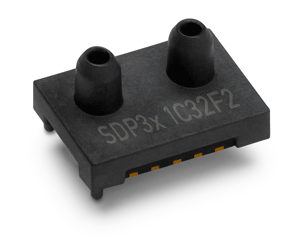
World’s smallest differential pressure sensor opens up new
applications
The new
SDP3x differential pressure sensor is considerably smaller than
other sensors in its segment. It can be built into devices which
previously lacked sufficient space for any sensory technology
at all. Thanks to the small sensor, existing devices can also
be made considerably smaller. The new sensor is particularly
suitable for portable or mobile medical devices in the field
of home care (medical ventilation) or for products in the consumer
goods industry.

The SDP3x sensor measures differential pressure and is ideal
for the measurement of mass flow in a bypass configuration.
And it’s not just its small size that's impressive –
it also stands out thanks to its accuracy, long-term stability,
and no zeropoint drift. The new SDP3x is reflow solderable and
available in a pick-and-place package on tape and reel for industrial
manufacturing. The small sensor also offers fast signal processing
and response time and includes various other digital functions
such as multiple I2C addresses and interrupts. All of these new
features make Sensirion's SDP3x series differential pressure
sensor the perfect choice for cost-sensitive applications requiring
high unit volumes.
The fully calibrated and temperature-compensated differential
pressure sensors are available in a variety of versions. The
SDP31 is digital with an I2C interface, and the SDP36 has an
analog output signal. Both versions measure a bi-directional
flow range of up to 500 Pa. In 2016, new products with extended
measurement ranges and different features will be added to the
SDP3x series. The different versions in the SDP3x series cater
to all customer needs.
The SDP3x differential pressure sensor is manufactured with the
latest generation of Sensirion's CMOSens® chips and is the
cornerstone of the new sensor platform for measurement of differential
pressure and gas flow. As with all sensors using
the patented CMOSens® Technology, the SDP3x also integrates
the sensor element and the evaluation circuit into a single CMOS
silicon chip. The result is an ultra-precision system that offers
long-term stability for sophisticated and cost-sensitive applications.
February
2016

